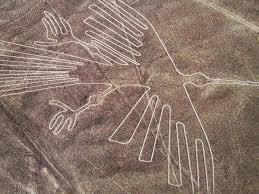(单词翻译:单击)
The latest line drawings discovered by archeologists in Peru show geometric figures portraying humans, apes and a whale, according to a report published in National Geographic.
根据《国家地理》杂志上发布的一份报告,秘鲁的考古学家日前发现了多幅绘制成人、猿和鲸鱼图案的地画。
Twenty-five images of the previously undocumented line drawings -- so-called geoglyphs, or "ground drawings" -- in Palpa province in southern Peru were taken from drones, said Peruvian archeologist Johny Isla Cuadrado.
秘鲁考古学家约翰尼·斯拉·库拉多表示,在秘鲁南部的帕尔帕省,无人机拍下了25幅之前没有记录过的地画。
Scientists flew the drones over the region about 30 meters above the ground, and spotted 50 geoglyphs -- 25 were unknown.
科学家们将无人机飞到了离地面30米高的地方,共发现了50处地画线条--其中25处是未知的。

Researchers hope that documenting the newly found line art will give them new insight into the area's ancient cultures.
研究人员希望,记录新发现的线条艺术将使他们对该地区的古代文化有新的认识。
Cuadrado said the massive drawings seem to point at "a tradition of over a thousand years that precedes the famous geoglyphs of the Nasca culture, and which opens the door to new hypotheses about its function and meaning."
库拉多表示,这些巨大的图画可能要比著名的纳斯卡文化地画早一千年,这为这些地画的功能和意义打开了新的假设。
Archeologists believe the Palpa drawings were created by the Paracas and Topara cultures between 500 BC and 200 AD, which would make them older by many centuries than the famous Nasca lines in the neighboring Nasca Valley.
考古学家认为,帕尔帕省的这些地画是由帕拉卡斯和托帕拉文化在公元前500年到公元200年之间创造的,这将使他们比邻近的纳斯卡山谷中著名的纳斯卡地画更为古老。


